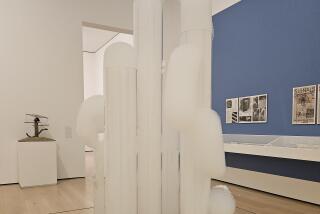Umbrellas of Christo : Once Again, Into the Mix of Art, Environment
Christo, the artist who stretched an opalescent fence across Sonoma County, wrapped the Pont Neuf in Paris and made pink lily pads out of islands in Miami’s Biscayne Bay, is in full swing again, this time on a project close at hand. To these eyes, it’s a sign as cheerful as spring.
Currently, he’s to be found on the art-museum circuit, talking up his vast new project, the Umbrellas. In a way, he’s spreading the word that will produce the necessary masses of workers for the big push in October. (Mostly minimum wage, no one under 18 allowed.) Even for Christo, who does not think small, the Umbrellas are a geographic stretch; they are to link Japan and California, at least conceptually.
On Oct. 8, like late jonquils, enormous yellow umbrellas will “meander in the landscape” over an 18-mile stretch of valley near the Tejon Pass. At the same time, in the rice fields of Ibaraki, 75 miles north of Tokyo, blue umbrellas will spring up like towering delphiniums.
These nearly 20-foot-tall octagonal umbrellas are Christo’s patented mix: theater, art, architecture, environmental planning and tireless, if friendly, persuasion. From what I gather, the spacing of the umbrellas--in tight precision in Japan, in almost sprawling abandon here--is a visualization of two very different ways people live on and use valley land. For example: the consent of 452 landowners was needed for the 12 miles the Umbrellas will cover in Japan; for California’s 18-mile stretch, the total number of landowners involved was 25.
I’m not sure that land-use density is what will spring to my mind standing under the umbrellas’ yellow shade in Gorman. Christo’s quoted reason for choosing this time and this season, when the valley’s “beautiful tall grass becomes golden like the hair of a blond child,” might not have been my image, either. But I wouldn’t miss the trip for the world. I am a Christophile of the worst kind, a convert.
In 1976, Christo set up Running Fence across Sonoma and, briefly, Marin County, just north of the Golden Gate Bridge. The accomplishment marked the end of Christo’s incredible four-year campaign to see his 18-foot fence snake its way across 24 1/2 miles of farmland in Sonoma. Living up there then, I remember very well the grass-roots reaction at the beginning of the project; it ran from dismissive to hostile.
In 1972, when Christo began his exercise in wooing/cajoling/persuading, rural Sonoma was not yet overrun with boutique wineries and gourmet produce stores. To most of its down-to-earth ranchers, Christo was one weird European. He called himself an artist, yet he relished dealing with state, county and federal agencies. It was “part of the work,” like creating Environmental Impact Reports thicker than the Sonoma phone book. He seemed at the very least a dreamer and probably a scammer. And if, at first, the ranchers were suspicious, local newspapers were virtually derisive.
Then, one September morning 42 months later, Running Fence was up. It appeared after emotional public meetings; after the 59 all-important ranch owners had been won over--and paid--to allow the fence to march across their land; after professional hard hats and students by the hundreds had been hired as the work corps, and after the media had been galvanized by the event.
Running Fence has been described as a white sail, but that makes it sound harsh and canvas-like. It was billowing nylon. And in a morning mist it could reflect the colors of dawn. That’s the hour I saw it, skimming above it in a two-seater plane, trying to fight down my fear of flying in anything smaller than a 747.
As we followed its route, it became the Great Wall of Sonoma, a dreamlike vision of Tom Sawyer’s whitewashed fence, an unfurling silk scarf whipping in the wind until it was pulled under the Pacific Ocean at Bodega Bay. Two weeks later, it was gone.
The lasting awe that Running Fence created came back with a rush, however, at the AFI International Film Festival last week as I watched the new Maysles Films’ “Christo in Paris.” (Watch for it on PBS later this year, time as yet unannounced.) Where Christo goes, the Maysles have never been far behind; although I had missed it until this year, they had captured every wind-whipped and emotional moment of “Running Fence” too.
“Christo in Paris” is their lyrical record of the artist’s 10-year struggle to wrap the 17th-Century Pont Neuf in Paris, and of a working love affair between the skinny Bulgarian emigrant and the general’s daughter, Christo’s well-born wife and partner, Jeanne-Claude.
Filmmakers Albert and the late David Maysles--in their last collaboration--Deborah Dickson and Susan Froemke catch the sardonic Ping-Pong politics between rival French political parties as well as the athleticism of the event itself: an ace “wrapper” moving between the golden fabric and the bridge like a Lilliputian under the covers with Gulliver.
Best of all, they record the project’s effect on ordinary Parisians, like the pink-gummed grandmother who suggests that if Christo wanted to throw his money away, he could do worse than give it to her. Or the pair of Frenchmen hotly debating the project’s merits, who agree on only one thing: that they would not ever be speaking if it were not for the wrapped bridge.
If it weren’t for the Maysles’ documentaries--Christo’s Valley Curtain, Running Fence, the Surrounded Islands--their only record would be still photographs, the artist’s drawings and others’ memories. Yet it’s not a filmed image that has remained with me, but a moment from my own vision of Running Fence--its last fluttering leap into the Bay.
I have no idea what the moment will be during the Umbrellas of October, or even if there’ll be one. But I know I’ll have to be there in the middle of it. And October can’t come too soon.
More to Read
The biggest entertainment stories
Get our big stories about Hollywood, film, television, music, arts, culture and more right in your inbox as soon as they publish.
You may occasionally receive promotional content from the Los Angeles Times.










